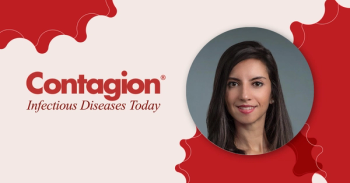
Improving Hospital Disinfection to Prevent C Diff
Edmund A. Hooker, MD, DrPH, discussed the gaps in disinfection in the hospital and how hospital beds can be properly sanitized to prevent the spread healthcare-associatedted infections.
In a presentation at the
In an exclusive interview with Contagion®, Dr. Hooker discussed his presentation and an innovative way to prevent infections in the hospital.
Contagion®: Could you speak to the current practices for cleansing in hospitals and what are some consequences that occur when hospitals are not properly disinfected?
Hooker: The problem is in the United States the hospitals are being cleaned with chemicals that don't work. When you have a lot of bacteria on a hospital mattress for example, which is my area of focus, you're trying to remove that bacteria before the next patient. Well, none of the things that people are using routinely whether that's quaternary ammonia, bleach, UV light, phenolic peracetic acid, all of those things only decrease the bacteria in the real world by about log 1 which means 90% decrease; that means 10% of the bacteria are still all over the mattress and ready for the next patient to be exposed.
Well we have this pressure we used to have tons and tons of hospital and tons and tons of hospital rooms now we have contracted, and we've got many less hospitals and most hospitals are running at a 95-110% occupancy, which means patients are waiting in the emergency room for a bed, patients are waiting in the operating room, and the recovery room for a bed, so the hospitals need those rooms turned over very quickly. So, they are spending usually 20 to 30 minutes to clean a room when in actuality it probably takes about 2 hours to clean the room. They're trying to do things in 1-step processes that really need 5-step processes. What happens is they go in there and they wipe with one wipe that's supposed to clean and disinfect all in 1 step and it just doesn't work.
So, the problem is when we're talking about the bed, the manufacturers of the bed the big companies that are making most of the beds in the United States, are recommending in their instructions for use that you do a 5 or 6 step process, pre-clean, remove most of the dirt off, and the soil, and the blood, and the poop. Then with clean soap and water, then rinse, then disinfect, then rinse again, then inspect everything to make sure there are no cracks or damage to the mattress. Most people are doing one step, they're doing a disinfectant, usually a quaternary ammonia, or a bleach sometimes peracetic acid, and so they are trying to remove all of this stuff in 1 step and it just is not going to work; the current system can not work.
Contagion®: What inspired you to conduct this research?
Hooker: Well, the Clostridium difficile (C diff) spores are very resistant to cleaning anyway, but the estimates are about 29,000 people killed a year by C diff, so this is a lot of people and hundreds of thousands of infections, about 100,000 of them start in the hospital, about a 150,000 start in nursing homes and about 100,000 start at home. But these are people that have been in contact with the health care system so lots and lots of people are being infected, people are dying.
There was just a presentation about long-term impact of people that get C diff and it's a real problem, these people are suffering and dying with the disease.
The problem with C diff if is you can die from just an initial C diff infection, what happens is it takes over your colon you end up perforating your colon and die of sepsis. My aunt died of C diff, that's what started me down this road; I have an aunt that I love very much, who got antibiotics for a wound our leg contracted C diff and died. This is real and so patients that survived it may have 6 months, a year, 2 years, 3 years before they're even well again they're in chronic pain, they're severely weak, they can't work, this is literally destroying hundreds of thousands of people's lives, either some in the short-term and some forever when it kills them.
Contagion®: What were the hallmarks of your presentation?
Hooker: I'm a real believer in clean prevents the problem. So, I’m going to present here in just a little while a second study that we just did where we took this launderable mattress cover and we put it on the beds and we cut infection rates by 59%. The reason is, the other study I'm going to present today, is that we launder the cover. So, if you take this cover off and you take it to a laundry and you wash it with soap, and bleach, and heat we kill everything. We started with over a billion C diff spores on this mattress cover and there were zero when I was done. And that's with the commercial laundry process it's nothing new and unusual there. It's been reports of the laundry process and in England failing on the sheets, it's because they don't do it long enough; their process is nothing like the process in this country.
So, we're using a commercial what's called an extractor, or some people call a pony washer, it's a load in the front and you pull out of that that load. The Tunnel washers, which are that what's used for most linen, you put the stuff in 1 side and you take it at the other side it's not as good a washer. A lot of laundries don't use heat, they use hydrogen peroxide. how do you practice is not going to kill C diff. So, we use a good laundry process that's well monitored, and we are able to cut infection rates of C diff by 59%.
We did a study at a long-term care acute care hospital a couple of years ago and we cut those by 50%. This is real, clean is the way to go. If you don't lie on a bed of poop, you're not likely to get C diff. So, we're really able to make a big impact.
Antibiotic stewardship is important and fecal transplants once you get C diff, but I'd rather prevent it. Look at this as a kind of like a vaccine, you know prevention is always better and that's what we're doing with this laundral mattress cover. I'm preventing you from being exposed to this dirty nasty bed.
[The idea] actually it came from Mr. Riffy who had been in the furniture industry, and he was fascinated that these beds were dirty, and he had had a family member gets C diff and he was like why can't we just make a cover? This cover is unique in that it covers not just the mattress it's actually a bed protection system that actually covers the bed deck. I challenge anybody next time you are at a hospital, lift the mattress up you may find a lot of dirt and rust up underneath that mattress; this protects everything. The bed deck which is that metal part, and the mattress are both protected, and by mounting it to the bed deck it actually articulates and works with the bed so it doesn't come off. We've all been in a bed that had the sheets pop off the corner well that can't happen this discovery, it's actually mounted down on to it, so this bed protection system, protects the bed from the patient and the patient from the bed.
Contagion®: What are the clinical implications of this data?
Hooker: Well it basically allows the hospital to do a couple things; One to ensure that the bed and bed deck are cleaned, which they aren't doing today. Two it lets them turn the bit room over quickly but yet still clean, so if they're taking a half an hour to an hour to clean the whole room, the toilet, the walls, the floor, and they can only take 3 minutes now to get that bed and bed deck clean by putting a new cover on. Now, all they've got to do is clean the handles on the bed and the rails, boom that patients ready to go. So, from a hospital standpoint, they're going to do very well.
We've got an economic analysis that will be presented next month at a national conference that showed the dollar savings. So, even though you pay for the cover and you have to launder the cover it ends up being cheaper because you prevent a lot of infections and you also get the bedrooms turned over quicker.
Contagion®: What are the next steps?
Hooker: We've already got this in a multitude or a couple of different hospitals and we've got getting ready to install in a major hospital system, I'm not allowed to divulge that one, that will be starting January 1 and we've got 2 other huge hospitals that are planning to implement it.
So, as we get more and more hospitals that have realized the economic benefits of putting the cover on, you know to me it's about patience and patient care, but to the hospitals they've got a they've got to make a bottom line it's actually going to be cheaper for them, because these health care acquired infections are not being paid for by the insurance company. So the hospital gets one payment a DRG (diagnostic related group) if that patient gets a C diff infection while they're there for their pneumonia, the hospital eats that. Costs have ranged anywhere from $14,000 of additional cost for that patient up to $35,000 depending on who you believe and how you calculate it. That's a lot of money and hospitals are already on a razor thin margin, so I think this could be a real savings to hospitals because it allowed them to ensure the patients are protected and it'll save them money in the long run.
We have a hospital that were today in Ashland, Kentucky, Bon Secours, that was able to cut their C diff rate by 59% now of course they did a lot of other things you know they're trying to do antibiotic stewardship, and doing all those things, but this was the main thing that caused the big decrease so it really makes a difference. And we had the long term acute care hospitals that also were able to drive down their infection rates
Newsletter
Stay ahead of emerging infectious disease threats with expert insights and breaking research. Subscribe now to get updates delivered straight to your inbox.


















































































































































































































































































